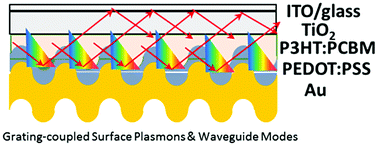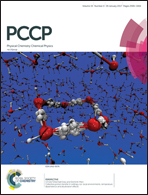Inverted organic solar cells enhanced by grating-coupled surface plasmons and waveguide modes†
Abstract
In this study, we demonstrate improved photovoltaic properties in inverted organic thin-film solar cells by simultaneous excitation of grating-coupled surface plasmons and grating-coupled waveguide modes on gold grating surfaces. The cell consists of a glass–ITO substrate/titanium dioxide/poly(3-hexylthiophene-2,5-diyl):phenyl-C61-butyric acid methyl ester/poly(3,4-ethylenedioxythiophene):poly(styrene sulfonate)/gold structure. The grating structures were fabricated on P3HT:PCBM layers using a nanoimprinting technique with a PDMS stamp. The grating-structured PDMS stamps were fabricated using a DVD-R grating template with a grating pitch, Λ, of 740 nm. Reflectivity measurements made using p-polarized light clearly indicate 2 types of excitation modes, i.e., surface plasmons and waveguide modes, while s-polarized light produces only waveguide modes. Incident photon-to-current efficiency measurements exhibited increased photocurrent wavelengths corresponding to the wavelengths of surface plasmon excitations and waveguide mode excitations. Through the simultaneous excitation of surface plasmons and waveguide modes, short-circuit photocurrents in the grating-structured cells exhibited an improvement of up to 11% in the solar cells, leading to an efficiency increase of 16%.


 Please wait while we load your content...
Please wait while we load your content...